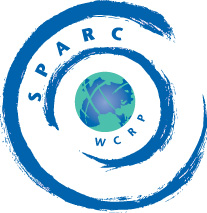 |
Stratospheric Processes And their Role in Climate
|
||||||||
| Home | Initiatives | Organisation | Publications | Meetings | Acronyms and Abbreviations | Useful Links |
![]()
 |
Stratospheric Processes And their Role in Climate
|
||||||||
| Home | Initiatives | Organisation | Publications | Meetings | Acronyms and Abbreviations | Useful Links |
![]()
Dr. Jan Lastovicka (jla@ufa.cas.cz)
Programme Committee: G. Beig (India), A.D. Danilov
(Russia), M.-L. Chanin (France),
J. Lastovicka (Czech Republic, chairman), J. Stegman (Sweden), G. Thomas (USA, vice-chairman).
The Workshop was organised by the Institute of Atmospheric
Physics (IAP) of the Academy of Sciences of the Czech Republic and co-organised by the Department of Meteorology
and Environmental Protection of Charles University under auspices of the IAGA/ICMA/PSMOS working
group "Long Term Changes and Trends in the Mesosphere, Thermosphere and Ionosphere" (LT-TIME).
About 50 scientists from 17 countries presented 47 oral papers, including 19 invited and invited review papers.
Refereed papers will be published in a special issue of the journal Physics and Chemistry of the Earth.
The Workshop has been supported by IUGG, SPARC, a Czech company (Prazska plynarenska), and IAP. EGS, IAGA,
ICMA/IAMAS and SCOSTEP have provided moral and informational co-sponsorship.
The focus was on trends in the mesosphere and ionosphere, but trends in the thermosphere, stratosphere and
troposphere were treated as well.
The Earth’s orbital variation will be extremely small in the next 50,000 years, which is expected to result
in an unusually long interglacial period. The doubling of the CO2, with respect to present concentration
would result in the disappearance of the Greenland ice sheet in about 4,000 years.
The global water vapour concentration in the stratosphere is reported to increase by about 0.05 ppmv/year.
Satellite observations confirm cooling of the whole stratosphere, which is significant above about 3 hPa but
rather marginal below. Increasing CO2, decreasing stratospheric ozone and increasing water vapour
contribute to this cooling. The effect of the solar cycle in stratospheric temperatures is important, therefore
data sets for trend investigations should be at least 20 years long.
Arguments were presented indicating that
ozone trends in the lowermost stratosphere observed at Payern (Switzerland) are predominantly of dynamical origin.
Also the longitudinal variation of trends at mid-latitudes in the Atlantic region seems to be mainly of dynmical origin.
About a quarter of the ozone decrease at mid-latitudes in Europe could be caused by a long-term change of the AO,
almost half of this decrease is related of the 100 hPa level (the influence of these two factors probably overlaps).
The overall ozone content in laminae in ozone profiles at 36-75oN had decreased from the late 1960 to
early 1990 by 50%. In combination with a strong seasonal variation of number of laminae, this contributed substantially to the seasonal
variation of trends in total ozone.
The round-table discussion on trends in mesospheric temperature made it clear that the differences between the
results obtained by different authors may be due to the dependence of the trends on latitude and longitude, altitude,
season and time of the day. The differences in the length and date of analysed periods also play some role, as
do instrumental and other technical problems.
The first draft version of the executive summary on the published papers dealing with trends in mesospheric and
mesopause region temperatures has been presented by the MTTA (Mesospheric Temperature Trend Assessment)
panel constituted under the auspices of the working group which organised this workshop. In the mid-latitudes the
lower mesosphere shows a trend of around –2oK per decade in several studies, but in the
middle mesosphere rockets results reveal a larger cooling (-7oK/decade) than lidar
(-3oK/decade). Contradictory results are reported for the mesopause region. The trend in the
summer mesopause is small or close to zero. Rocket launches in Scandinavia in summer do not reveal any trend
of temperature at 82 km (the noctilucent cloud height). Model computations provide a twice as large response of
mesospheric temperature to the increasing greenhouse gas content in winter as compared to summer. Airglow
emission measurements in Sweden provide even larger winter-summer difference in temperature trends. The
implied shrinking of the mesosphere deduced from temperatures inferred from airglow measurements is about
50 m/year near 70 km (increased to 120 m/year near 100 km).
The water vapour content in the mesosphere was increasing since the 1950s by about 1%/year. Such an increase
cannot be fully explained by the increasing concentration of methane. HALOE measurements at 75 km over
1991-2001 revealed a positive trend in ozone concentration of 2-3 %/decade at sunrise but no detectable trend
at sunset. From measurements at Collm, the prevailing wind rather strengthened over 1980-2000, which
contradicts the results from some other stations.
Our knowledge and understanding of trends in the lower ionosphere is insufficient. The available results indicate
an increase in electron density at lower altitudes as a consequence of changes in chemistry of minor constituents
and the thermal shrinking of the mesosphere due to greenhouse cooling.
Trends in the E and F1 layers of the ionosphere seem to be reasonably consistent with model expectations:
foE and foF1 increases, h’E decreases. Results of different authors on the F2-layer ionosphere trends
differ substantially even as to sign.
![]()